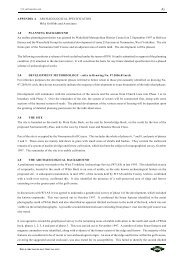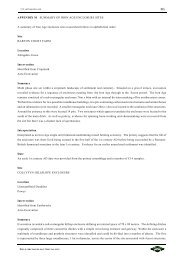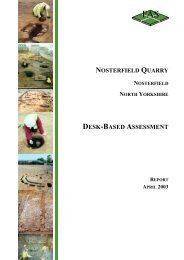ARCHAEOLOGICAL EVALUATION - Mike Griffiths and Associates
ARCHAEOLOGICAL EVALUATION - Mike Griffiths and Associates
ARCHAEOLOGICAL EVALUATION - Mike Griffiths and Associates
You also want an ePaper? Increase the reach of your titles
YUMPU automatically turns print PDFs into web optimized ePapers that Google loves.
FAS_lbf01.wpd 179<br />
The subsidence hollows recorded to date at Ladybridge Farm have contained only mineral sediment fills with<br />
no evidence for waterlogging <strong>and</strong> the survival of organic matter. The palaeoenvironmental significance of these<br />
particular hollows is considered to be negligible.<br />
Other subsidence hollows may be present within lower-lying parts of the site <strong>and</strong> these may be waterlogged.<br />
If present, <strong>and</strong> depending on their history of subsidence, these hollows may contain a detailed vegetation record<br />
for the area immediately surrounding the hollow. The significance of this record will depend on its date,<br />
duration <strong>and</strong> temporal resolution. Long, high-resolution records of mid- to late-Holocene date will be of high<br />
significance in a local context as they will inform archaeologists about the local environment at a time when<br />
there was human activity in the area. Short duration, low resolution or early Holocene records will be of low<br />
to negligible significance.<br />
The larger depressions recorded at Ladybridge Farm contain waterlogged sediments, including peat, <strong>and</strong><br />
therefore have a high potential to provide palaeoenvironmental information. The value of this information will<br />
depend on the age range of the deposits but the evidence from Nosterfield suggests that the deposits will be too<br />
early to be of archaeological value. This resource is therefore considered to be of low significance.<br />
11.0 ARCHIVE<br />
A medium-sized assemblage of ceramic <strong>and</strong> clay tobacco pipe <strong>and</strong> ceramic building material were recovered<br />
during evaluation (688; 591). The material is of late post-medieval to modern date <strong>and</strong> no further analysis is<br />
recommenced for the assemblages. A medium assemblage of lithic material (410) has been the subject of<br />
assessment <strong>and</strong> selected illustration has been recommended. A small assemblage of prehistoric pottery has been<br />
the subject of assessment <strong>and</strong> selected illustration <strong>and</strong> sherd consolidation has been recommended. A small<br />
assemblage of animal bone has been the subject of a specialist assessment <strong>and</strong> no further work is recommended<br />
for the material. 230 litres of soil were retained during fieldwork <strong>and</strong> have been the subject of full processing<br />
<strong>and</strong> assessment. Other finds of glass (81) metalwork (11), slag (1) <strong>and</strong> plastic objects (1) were of late postmedieval<br />
to modern date <strong>and</strong> no further analysis is recommended; a full index of all the material is available for<br />
consultation at FAS.<br />
The site archive <strong>and</strong> material assemblages are currently held by Field Archaeology Specialists. A paper <strong>and</strong><br />
electronic copy of the report will be deposited with the Heritage Unit of North Yorkshire County Council.<br />
FIELD ARCHAEOLOGY SPECIALISTS







